Introduction
The probes attached to oscilloscopes are fundamental to getting useful captures and measurements from the ‘scope. The normally seen ‘scope probes (technically they’re called passive probes) have a special construction that is not easy to DIY; it’s best to purchase these. They have a distributed resistance running all along the wire (it is not ‘normal’ coax!) and without that the oscilloscope will display a distorted signal.
Many such passive probes come with a pointy tip and with attachments such as grippers. The probe end can sometimes be inserted into sockets too. However, it is rarer for supplied probes to come with a solderable wire attachment (although some probes do come with that). This blog post documents an experiment to build solderable probes, the idea being that the probes can be quickly tacked with solder directly onto the board under test.
I had written some notes for building custom probes several months ago, but I’d not got around to documenting it because I did not have a decent way to test it all. Since then, Building a Fast Edge Square Wave Generator allowed me to collect some measurements.
This blog post may be useful for those who need low-cost ‘scope probes, or for those who want solderable probes for attaching to a circuit board, temporarily or even semi-permanently. For another technique for using probes, see DIY $10 Solder-in Oscilloscope Probe
It can sometimes make a huge difference to usability, not needing to hold probes in position manually! To cut a long story short, all it entails is soldering a 950 ohm (or 953 ohm - easier to find!) resistor inline with the center conductor of a coax cable. It is inside the yellow pod in the photo below. Connect the other end to your 'scope and set it to 50 ohms, and that's pretty much it : )
If you’ve recently purchased an oscilloscope, hopefully, it came with ‘scope probes but if it didn’t, you can make these! However, there are limitations; the probes described in this blog post have an impedance of 1 kohm. This is lower than typical passive probes that come with oscilloscopes, so it may load the signal to be measured too much. The best approach to using the solderable probes described in this blog post would be to first briefly check with a normal passive probe to see what the signal should look like.
Why not just use Coax Cable
One school of thought could be to get a coax cable, attach one end to the ‘scope and the other end to the signal on the device under test. Ordinary coax cable can be used in such a scenario but only if the signal is intended for a 50 ohm load, and the ‘scope is set accordingly to a 50 ohm termination.
It is best to avoid ‘unusual’ attachments like BNC-to-banana or BNC-to-alligator, or ordinary coax cable, unless you’re very sure of what you’re expecting to measure, otherwise, one will get burned sooner or later with confusing ‘scope trace results.
If the oscilloscope is not set to 50 ohms load, then fast-changing signals will appear distorted; there is an explanation for this here.
Also, it’s good to avoid setting the ‘scope to 50 ohms unless you’re really sure that the signal source can handle this low impedance, and that the ‘scope input can handle the power going into it’s internal 50 ohm resistor - to prevent blowing up the 'scope input.
Some oscilloscopes do not have a 50 ohm input. For such ‘scopes with up to around 200 MHz bandwidth, it is ok to use either an inline 50 ohm resistance or a BNC T-piece with 50 ohm terminator. Note however that nearly all low-cost 50 ohm BNC terminators are designed for old-school local area network or LAN connections and will not work very well; it’s best to buy a terminator specifically intended for operation at high frequencies, or make your own!).
How Do Probes Work?
‘Normal’ Passive Probes
Normal oscilloscope probes (also known as 10X or 100X passive probes) use a specialized, custom cable for ultra-low capacitance. This is needed in order not to attenuate the signal too much at high frequencies. At either end of the cable, passive components are used to create a potential divider circuit, so that the circuit under test is not impacted much when the probe and ‘scope are attached to it. The potential divider circuit is a bit specialized because it includes a compensation capacitance within the divider, so that the (unwanted but inevitable) ‘scope input capacitance, combined with the probe cable capacitance, does not act as a low-pass filter. This type of ‘scope probe is better purchased than DIY’d!
Resistive Probes
An alternative type of probe, known as a resistive probe, has a simpler topology. It relies on normal coax cable. Typical ’50 ohm’ labelled coax cable has a property that, if the far end of it is connected to a 50 ohm resistor, means that any signal input at the other end will also see a pure 50 ohm resistance and actually won’t see any reactance, regardless of the capacitance and inductance of the coax. As a result, the potential divider can be greatly simplified compared to a conventional passive probe! (The feature of coax that causes this behavior is known as its transmission line property, and that property enables many operations transporting signals in systems, especially communications circuits, networks and computers).
Resistive probes are described in online and offline literature. The Art of Electronics suggests using a 950 ohm (or 953 ohm since that is an E24 value) resistor in series with the coax cable, at the signal end. The potential divider formed with the 50 ohm oscilloscope input setting, therefore, reduces the voltage by 20 times. The resistor value is a compromise; too high a resistance and the signal is attenuated too much for the oscilloscope to display well, and too low a resistance and the circuit under test gets loaded too much. Since a resistor is not perfectly resistive and has some capacitance and inductance too, the construction of the resistor can have an affect too, and the impact of that may differ depending on the resistance value as well.
Using a 950 ohm resistance, the circuit will see a 1 kohm load when the far end of the probe is terminated with a 50 ohm resistor. 1 kohm isn’t great for all scenarios, however for many circuits, especially logic gate outputs, it can be acceptable to attach to such a load.
With microcontroller and digital circuits, it can often be necessary to probe several connections for serial busses, and it could be awkward to use many probe clips while debugging. A solderable option for the probes could be attractive for that scenario.
Building It
Construction can be very straightforward. Any 50 ohm coax cable can be used. Attach a BNC connector to one end. If you don't feel comfortable doing that, it is possible to purchase BNC-to-BNC cables and cut in half, or chop off one end.
For the resistor, a 1% tolerance 953 ohm thick film (not thin-film) resistor can be used, or perhaps a 5% tolerance 1 kohm resistor (many could be purchased, and individually measured to select the ones closest to 950 ohm).
For my implementation, I used RG-178 coax. If you’re unfamiliar with it, it’s one of the most useful coax types for electronics labs as general-purpose hookup-coax, because it is so easy to work with, and excellent for short connections. It is thin (1.8 mm overall diameter) and the outer insulator is easily removed by lightly scoring with a knife, bending the coax slightly to tear at the score, and then gripping with wire cutters and sliding it off. Another excellent property is that it’s almost impossible to melt the inner insulator (dielectric) when soldering.
I wanted to make several of these probes, so I used heat-shrink tubing at each end for color-coding. I used 2.5 mm2 ferrules to terminate the outer braid, however, it’s not necessary; you could just spin the braid around the outer insulation and tin it with solder to form a circular termination, all ready for attaching a ground cable. Since the coax is so thin, the outer termination could also be directly soldered to the nearest ground point or ground plane on the circuit board under test.
The diagram below contains measurements in case anyone wants to assemble it in a similar way, to get comparable results as I got. I'm not saying my method was good or bad; it's just one data point, so experimentation could improve the results further.
I used an 0805-sized 953 ohm thick film resistor, and fairly thin 30AWG stranded PTFE-insulated wire. This will allow me to solder the probes even in fairly dense locations on a PCB.
The resistor and the connections to it were covered in ‘instant’ epoxy glue (it sets in a minute or two), and I tried to get glue over the insulation of the wire too, to secure it all properly. Maybe this step isn’t required.
Next, to make the colored plastic blobs, Polydoh was used. If you’ve not used it before, it is like a manual version of 3D printing plastic; it melts at a low temperature and can be formed with ease. It comes as a bag of white granules/pellets and can be purchased bundled with pigment granules too, to be mixed in. It is really cheap – about $15 for a bag containing thousands of granules.
Ordinarily, the granules are supposed to be used with boiling water, but I didn’t want to get my resistor wet, so an alternative procedure was used. I took two granules and placed them on a surface (I used a metal block) and heated it with a hot air tool. After a few seconds, it was possible to place the wire and resistor between the two granules and fold it all around into a kind of pod or egg-shape, using bare fingers (it doesn’t burn the fingers, just feels slightly hot briefly). If it hardens too soon before it is fully shaped, then it can be re-heated with the hot air tool.
If you don’t want white blobs and want to color-co-ordinate with the ‘scope channel colors, then instead of just heating two granules, add a single pigment granule too, and then mash the molten color into the molten granules with fingers, and then (because it will have cooled and solidified) place back on the block and re-heat, and then wrap it around the resistor and form the blob. It’s really easy!
Using It
For peace of mind, as mentioned earlier, if you’re unsure what sort of signal levels to expect, a normal passive probe should be first used to be aware of what the signal should approximately look like.
To use the resistive probe, if your oscilloscope has a 50 ohm termination setting, that needs to be enabled. Otherwise, a 50 ohm terminator and a BNC T-piece is required for each probe. This is mandatory.
Next, set the oscilloscope scaling to 20X. If the oscilloscope does not support such a setting, then the scaling will need to be done mentally because the displayed voltage levels will be scaled down by that factor.
Solder on the probe to the circuit under test, attach the probe to the ‘scope and power up the circuit under test!
Comparison with Other Probing Methods
For a test signal, I used a square wave generator circuit (see Building a Fast Edge Square Wave Generator ). The reference signal (captured with a plain 50 ohm coax connection to the ‘scope) is shown at that blog post, and will be used for comparison purposes as a near-ideal capture.
I tested three different probing methods:
- Simple plain coax connected to the square wave generator, and the oscilloscope set to its normal 1 Mohm setting. This will be a bad method as will be visible in the ‘scope traces.
- The home-made resistive probe, connected to the oscilloscope set to 50 ohm input
- Active FET probe. This probe should give good results but is a pricey option. It will be good to compare the results.
The photos below show the three different methods. For all three methods, the square wave generator output was directed into a 50 ohm load, which can be seen screwed onto the SMA connector at the top of each photo.
The oscilloscope traces below show the results for each of the probing methods. The reference trace (from the square wave generator blog post) is shown on the right for easy comparison. The coax method was, as expected, bad. Coax 1 and Coax 2 were attempts with different lengths of coax, and it made a difference, again as expected. In summary, both Coax 1 and Coax 2 look bad, with Coax 2 happening to look extremely bad. This is the danger of just using coax like this; the result can look extremely distorted.
The resistive probe results are shown below. There is a small anomaly visible about 8 nanoseconds from the time of the rising edge, but aside from that the result looks fairly similar.
The result from the active probe is shown below. There are a couple of small differences here and there, but generally the trace looks similar to the reference.
Summary
Solderable ‘resistive’ oscilloscope probes are easy to create, and although they won’t be suitable for all circuits, they can be handy for attaching to awkward locations for some circuits under test. The results show there really isn’t much difference between the expected reference trace, and the result with the solderable probe looks fairly good! It is not as general-purpose as a normal passive probe nor as high impedance as an active probe. The resistive probe will not be suitable for all purposes due to the 1 kohm impedance it presents to circuits, however, it could be handy from time to time. As mentioned earlier in the blog post, another solderable option is to try to attach the normal passive probe into a circuit using a PCB probe socket.
Thanks for reading!

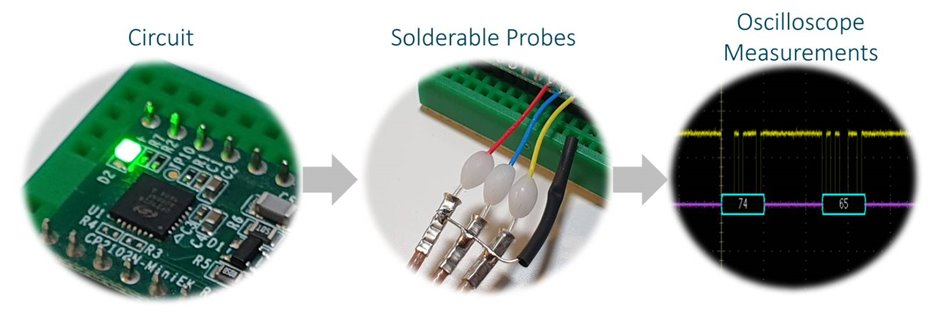
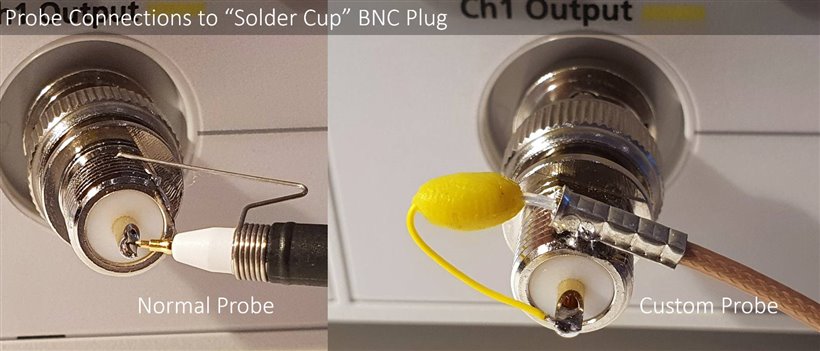
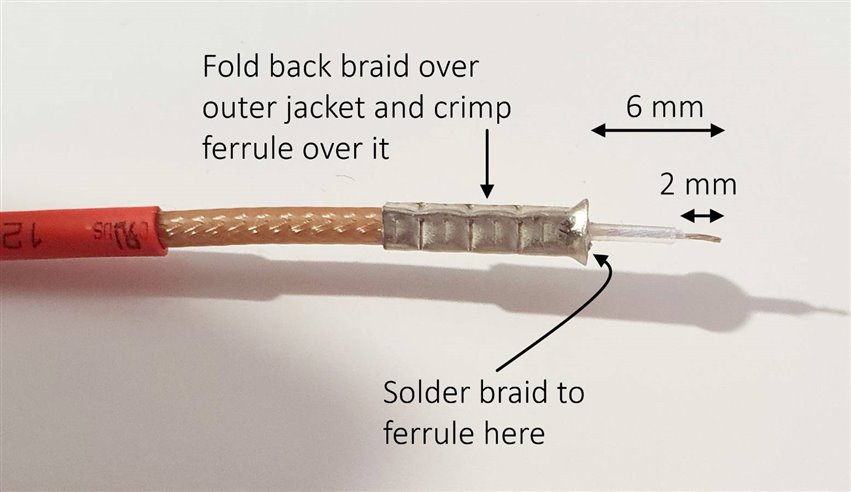
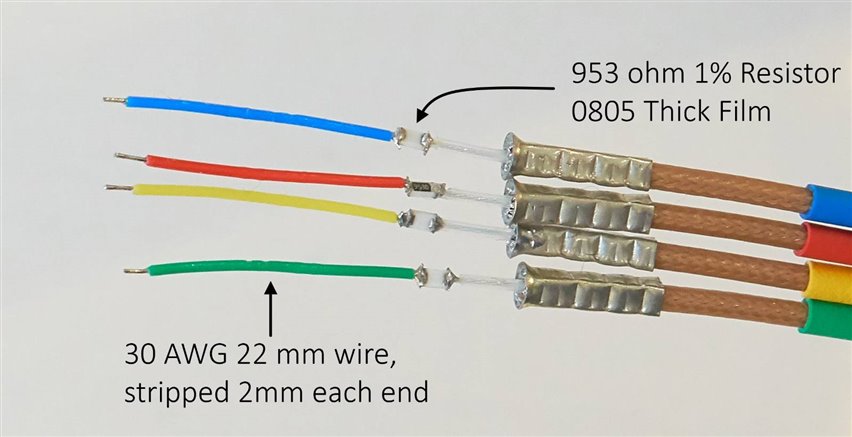
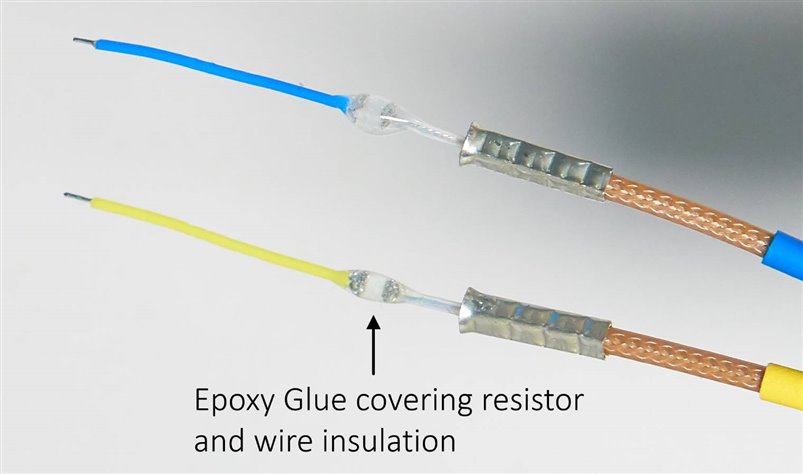
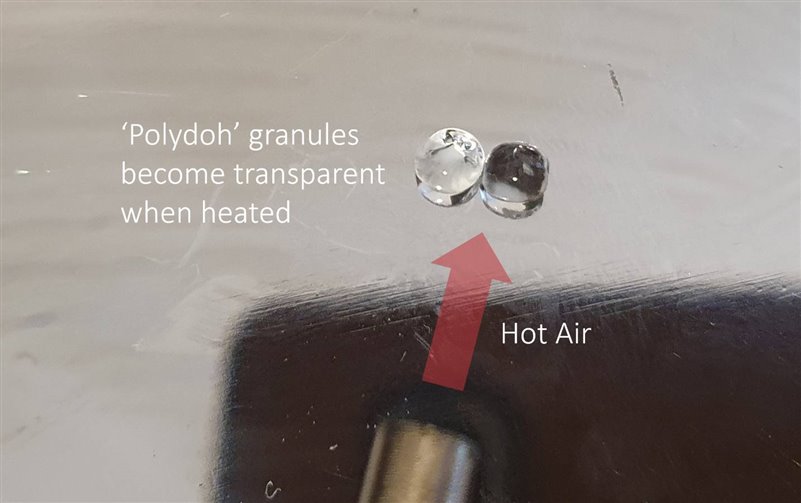
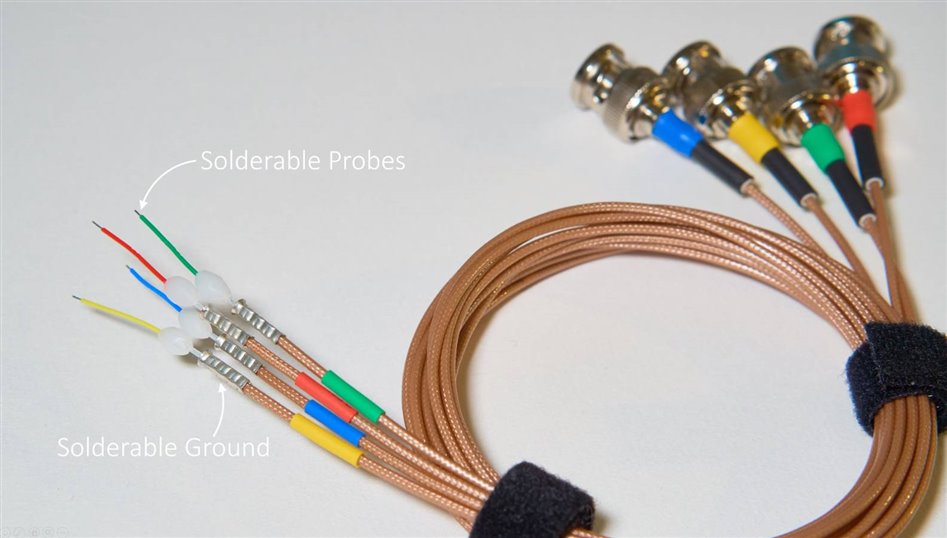
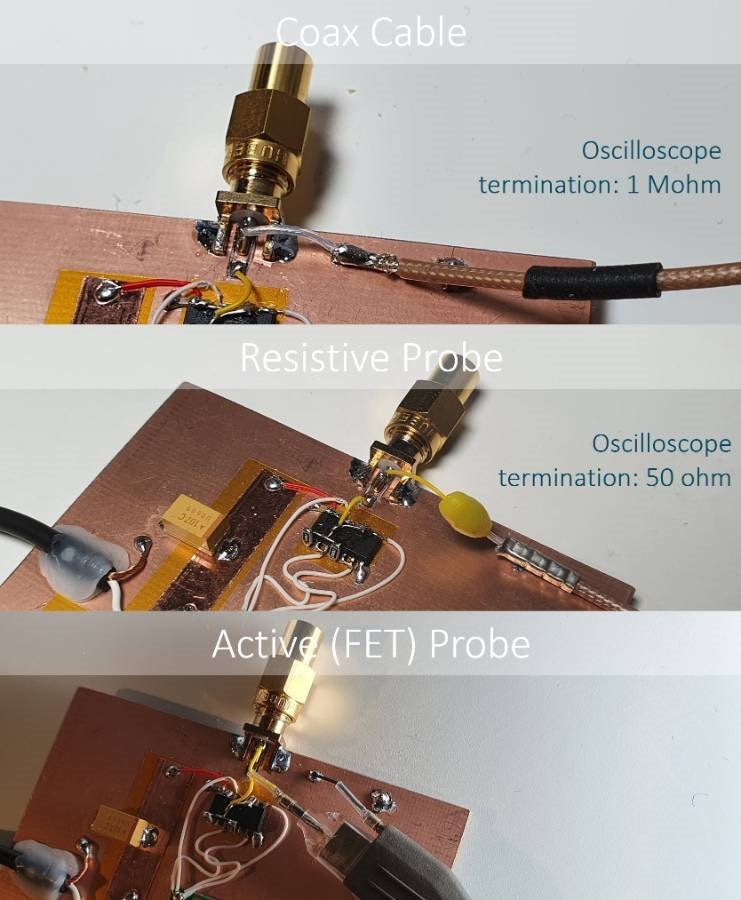
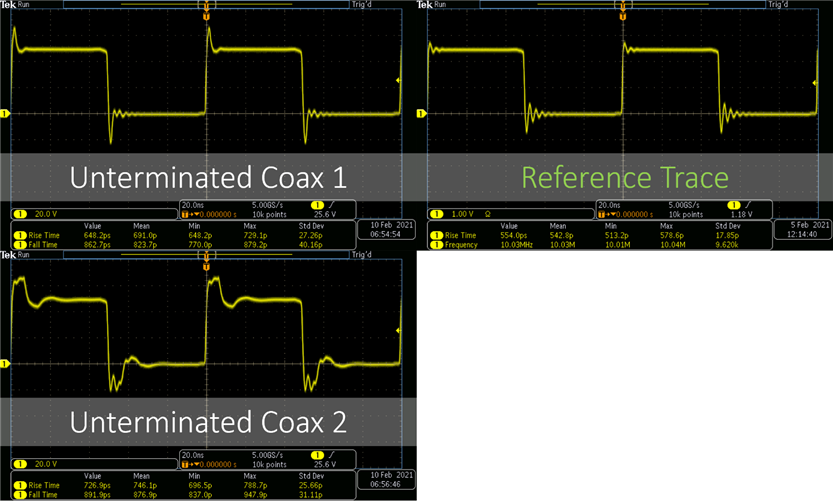
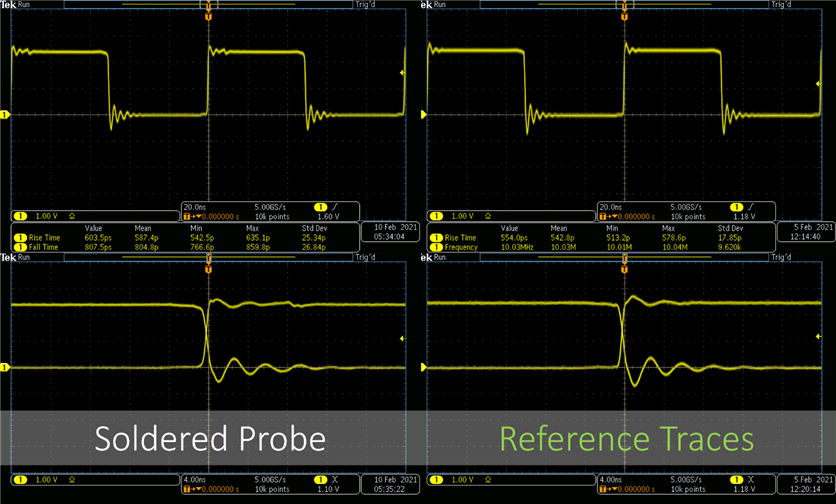
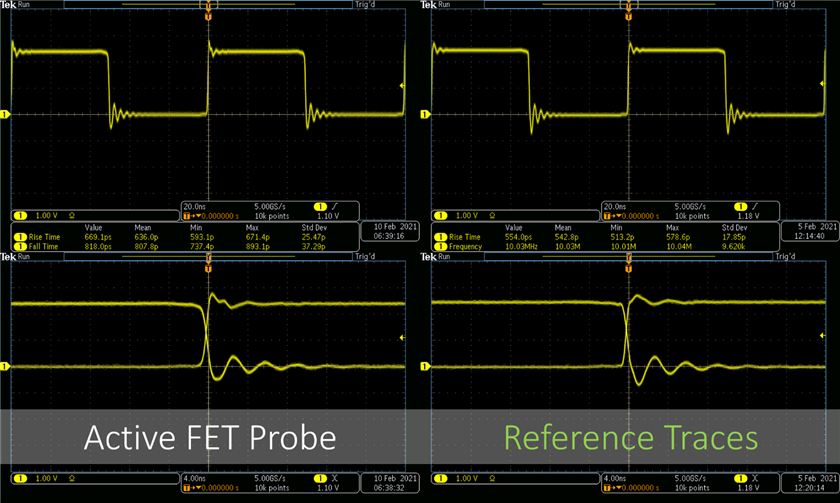
Top Comments
-

jc2048
-
Cancel
-
Vote Up
+5
Vote Down
-
-
Sign in to reply
-
More
-
Cancel
-

shabaz
in reply to jc2048
-
Cancel
-
Vote Up
+3
Vote Down
-
-
Sign in to reply
-
More
-
Cancel
-

Jan Cumps
in reply to jc2048
-
Cancel
-
Vote Up
+4
Vote Down
-
-
Sign in to reply
-
More
-
Cancel
-

shabaz
in reply to Jan Cumps
-
Cancel
-
Vote Up
+4
Vote Down
-
-
Sign in to reply
-
More
-
Cancel
-

Jan Cumps
in reply to shabaz
-
Cancel
-
Vote Up
+4
Vote Down
-
-
Sign in to reply
-
More
-
Cancel
-

shabaz
in reply to jc2048
-
Cancel
-
Vote Up
+4
Vote Down
-
-
Sign in to reply
-
More
-
Cancel
-

genebren
in reply to shabaz
-
Cancel
-
Vote Up
+3
Vote Down
-
-
Sign in to reply
-
More
-
Cancel
Comment-

genebren
in reply to shabaz
-
Cancel
-
Vote Up
+3
Vote Down
-
-
Sign in to reply
-
More
-
Cancel
Children